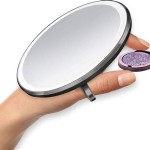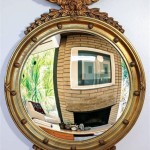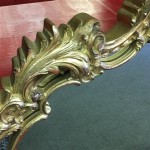How To Hang a Mirror Without Wire
Hanging a mirror can enhance any room, adding light, depth, and a touch of elegance. While traditional methods often involve wires and hooks, several effective alternatives exist for those seeking a cleaner, more minimalist aesthetic or facing challenges due to wall composition or mirror weight. This article explores various methods for hanging mirrors without wire, providing detailed instructions and considerations for each technique to ensure a secure and visually appealing result.
Before commencing any mirror-hanging project, several preliminary steps are crucial. These include assessing the mirror's weight, selecting the appropriate hanging method based on the mirror's size and the wall type, and gathering the necessary tools and materials. Ignoring these preliminary steps can lead to damaged walls, unstable mirrors, or even personal injury.
The weight of the mirror is a primary factor in determining the appropriate hanging method. Lighter mirrors, generally those weighing under a few pounds, can often be supported by adhesive solutions. Heavier mirrors, however, require more robust anchoring methods to ensure they remain securely in place. Always err on the side of caution and choose a method rated for a higher weight capacity than the mirror's actual weight.
The type of wall also plays a significant role in selecting the optimal hanging technique. Drywall, plaster, and concrete walls each present different challenges and require different types of fasteners. Drywall is relatively weak and requires anchors to provide sufficient support. Plaster can be brittle and prone to crumbling, necessitating careful drilling and the use of appropriate anchors. Concrete walls are the most durable but require specialized drill bits and heavy-duty anchors.
Finally, gathering the necessary tools and materials before starting the project will streamline the process and prevent frustration. Essential tools typically include a level, measuring tape, pencil, drill (with appropriate drill bits for the wall type), screwdriver, and safety glasses. Materials will vary depending on the chosen hanging method but may include heavy-duty adhesive strips, mirror mounting clips, D-rings, picture hanging nails, wall anchors, screws, and construction adhesive.
Using Heavy-Duty Adhesive Strips for Lightweight Mirrors
Heavy-duty adhesive strips offer a convenient and relatively damage-free solution for hanging lightweight mirrors. These strips utilize a strong adhesive that bonds to both the mirror and the wall surface, providing a secure hold without the need for drilling or nails. However, their weight capacity is limited, making them suitable only for smaller, lighter mirrors.
The first step in using adhesive strips is to thoroughly clean both the back of the mirror and the wall surface where the mirror will be hung. Use a clean cloth and a mild degreasing cleaner to remove any dust, dirt, or grease that could interfere with the adhesive bond. Allow both surfaces to dry completely before proceeding.
Next, carefully apply the adhesive strips to the back of the mirror, following the manufacturer's instructions. Typically, this involves peeling off the protective backing and pressing the adhesive side firmly onto the mirror. Ensure the strips are evenly spaced and positioned near the edges of the mirror to maximize support. The number of strips required will depend on the mirror's size and weight, so consult the product packaging for guidance.
Once the adhesive strips are securely attached to the mirror, carefully position the mirror on the wall, using a level to ensure it is straight. Press the mirror firmly against the wall for the recommended amount of time, usually around 30 seconds to one minute. This allows the adhesive to bond properly to the wall surface. Avoid immediately releasing the mirror and allow the adhesive to set for the recommended time (usually several hours or overnight) before removing any support.
While adhesive strips offer a convenient solution, it is crucial to choose a product specifically designed for hanging mirrors and to adhere strictly to the manufacturer's weight recommendations. Overloading the adhesive strips can lead to the mirror falling and causing damage or injury. It's also important to note that removal of adhesive strips can sometimes damage the wall surface, especially if the paint is old or poorly adhered. Testing a small, inconspicuous area first is recommended.
Employing Mirror Mounting Clips for Medium-Weight Mirrors
Mirror mounting clips provide a more secure and versatile method for hanging mirrors, particularly those of medium weight. These clips are typically made of metal or plastic and are designed to grip the edges of the mirror, holding it securely against the wall. They offer a clean, minimalist look and can be used with a variety of wall types.
Before installing mirror mounting clips, carefully measure the mirror and mark the desired location on the wall. Use a level to ensure the marks are straight and evenly spaced. The number of clips required will depend on the size and weight of the mirror, but typically, four clips are used – two at the bottom to support the weight and two at the top to secure the mirror in place. For larger or heavier mirrors, additional clips may be necessary along the sides for added support.
Once the marks are in place, drill pilot holes at each mark, using a drill bit appropriate for the wall type. For drywall, use wall anchors to provide a secure attachment point for the screws. Insert the anchors into the pilot holes and then screw the mirror mounting clips into the anchors. Ensure the clips are aligned properly and that the screws are tightened securely but not over-tightened, which could damage the wall.
With the bottom clips in place, carefully lift the mirror and rest it on the bottom clips. Then, position the top clips so they grip the top edge of the mirror securely. Screw the top clips into place, ensuring the mirror is level and stable. Double-check that all clips are securely fastened and that the mirror is held firmly against the wall.
Mirror mounting clips offer a robust and reliable method for hanging mirrors, but proper installation is essential. Using the correct type of wall anchors for the wall type and ensuring the clips are securely fastened are crucial for preventing the mirror from falling. This method also requires careful measurement and precise drilling to ensure the mirror is properly aligned and supported.
Utilizing D-Rings and Picture Hanging Nails for Larger Mirrors
For larger, heavier mirrors, D-rings and picture hanging nails offer a traditional yet effective solution. This method involves attaching D-rings to the back of the mirror and then hanging the mirror on picture hanging nails or hooks that are securely anchored to the wall. This approach provides a strong and stable support system for heavier objects.
Begin by attaching the D-rings to the back of the mirror. The D-rings should be positioned symmetrically near the top of the mirror, ensuring they are strong enough to support the mirror's weight. Use screws that are appropriate for the mirror's frame material and ensure they are securely fastened. Reinforcing the areas where the D-rings are attached with small metal plates or wood blocks can add extra strength and prevent the screws from pulling out.
Next, measure the distance between the D-rings and mark the corresponding location on the wall. Use a level to ensure the marks are straight and evenly spaced. The picture hanging nails or hooks should be positioned slightly higher than the D-rings to allow the mirror to hang properly.
Install the picture hanging nails or hooks at the marked locations. For drywall, use wall anchors to provide a secure attachment point. Insert the anchors into the pilot holes and then hammer or screw the nails or hooks into the anchors. Ensure the nails or hooks are rated for the weight of the mirror and that they are securely fastened to the wall.
Finally, carefully lift the mirror and hang it on the picture hanging nails or hooks. Ensure the D-rings are properly engaged with the nails or hooks and that the mirror is level. Double-check that the mirror is securely supported and that there is no risk of it falling. Adjust the position of the nails or hooks if necessary to achieve a level and stable hang.
This method, while reliable, requires careful attention to detail and the use of high-quality materials. Choosing D-rings and picture hanging nails that are rated for the mirror's weight is crucial, as is ensuring the nails or hooks are securely anchored to the wall. Regularly inspecting the hanging hardware is also recommended to ensure it remains in good condition and that the mirror remains securely supported. The type of nails used should be considered, selecting options designed for the wall material to minimize damage and ensure adequate hold.
Regardless of the chosen method, safety should always be a top priority when hanging a mirror. Wearing safety glasses to protect the eyes from dust and debris is essential, as is using caution when drilling or hammering. If the mirror is particularly heavy or unwieldy, enlisting the help of another person is recommended to prevent accidents. Always consult the manufacturer's instructions for any hanging hardware or adhesive products being used, and do not hesitate to seek professional assistance if unsure about any aspect of the process. Selecting the correct hanging method and taking the time to install the mirror properly will ensure a beautiful and secure addition to any space.
How To Hang A 100 Pound Mirror On Drywall Quora

How To Hang A Heavy Mirror

How To Hang A Heavy Mirror The Home Depot

How To Hang A Hanging Mirror Without Accompanying Hardware

How To Adjust A Mirror Art Or Picture Hanging Wire

Picture Wire Strung Between Two D Rings Attached To The Back Of A Frame Hanging Mirror Heavy Installation

How To Hang A Heavy Mirror Or Picture True Value

How To Hang A Heavy Mirror On Brick Wall Hanging Tips Easy Tutorial Homify

How To Hang A Heavy Mirror In 5 Simple Steps

Hang Mirror Without Wire Tiktok Search








